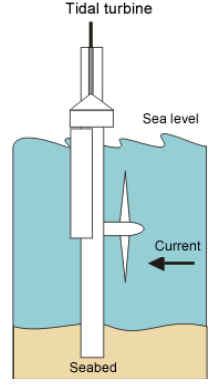Renewable-energy / Renewable Energy / Tidal Energy
- The gravitational pull of the moon and sun along with the rotation of the earth create tides in the oceans. In some places, tides cause water levels near the shore to rise and fall up to 40 feet. Today, there are tidal energy systems that generate electricity. Producing tidal energy economically requires a tidal range of at least 10 feet.
Tidal barrages
- One type of tidal energy system uses a structure similar to a dam called a barrage. The barrage is installed across an inlet of an ocean bay or lagoon that forms a tidal basin. Sluice gates on the barrage control water levels and flow rates to allow the tidal basin to fill on the incoming high tides and to empty through an electricity turbine system on the outgoing ebb tide. A two-way tidal power system generates electricity from both the incoming and outgoing tides.
Advantages
- Tidal energy is a clean, renewable, sustainable resource that is underutilized and represents significant opportunity to meet growing global energy needs, both now and in the future. Water is hundreds of times denser than air, which makes tidal energy more powerful than wind. It is more efficient than wind or solar energy due to its relative density and produces no greenhouse gases or other waste, making it an attractive renewable energy source to pursue.
- Also beneficial is the relative predictability and reliability of continuous tides, especially compared to other renewable energy sources like wind and solar, which are affected by the variability and uncertainty of atmospheric forcing. Low tide and high tide cycles are easy to predict and rarely experience unexpected changes.

Disadvantages
- A potential disadvantage of tidal power is the effect a tidal station can have on plants and animals in estuaries of the tidal basin. Tidal barrages can change the tidal level in the basin and increase turbidity (the amount of matter in suspension in the water). They can also affect navigation and recreation.
Tidal turbines
- Tidal turbines are similar to wind turbines in that they have blades that turn a rotor to power a generator. They can be placed on the sea floor where there is strong tidal flow. Because water is about 800 times denser than air, tidal turbines have to be much sturdier and heavier than wind turbines. Tidal turbines are more expensive to build than wind turbines but can capture more energy with the same size blades.
Tidal fences
- A tidal fence is a type of tidal power system that has vertical axis turbines mounted in a fence or row placed on the sea bed, similar to tidal turbines. Water passing through the turbines generates electricity.
Potential of tidal energy in India
- The most attractive locations are the Gulf of Cambay and the Gulf of Kachchh on the west coast where the maximum tidal range is 11 m and 8 m with average tidal range of 6.77 m and 5.23 m respectively. The Ganges Delta in the Sunderbans in West Bengal also has good locations for small scale tidal power development. The maximum tidal range in Sunderbans is approximately 5 m with an average tidal range of 2.97 m.
- The identified economic tidal power potential in India is of the order of 8000-9000 MW with about 7000 MW in the Gulf of Cambay about 1200 MW in the Gulf of Kachchh and less than 100 MW in Sundarbans.

